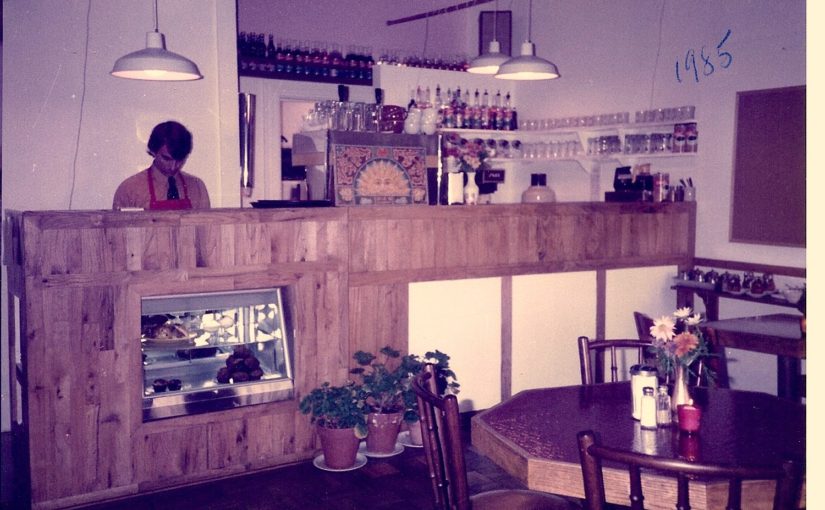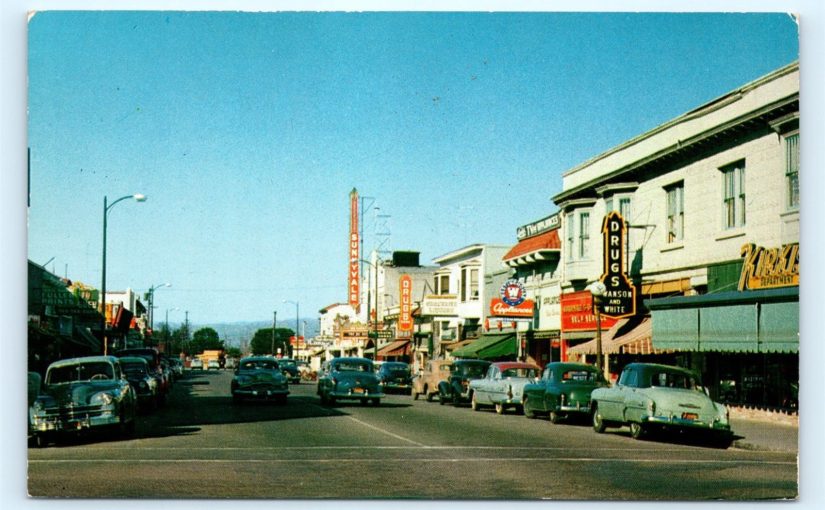“Why don’t you offer things people want to eat?” asked my mother only a few days after I opened Caffe Domenica in Santa Cruz.
“Like what, Mom?”
“You know, hot dogs, hamburgers.”
“It’s an Italian caffe. Hot dogs and hamburgers aren’t typically Italian.”
“I know Italians who eat them.”
“That’s different.”
“And that hot chocolate wasn’t sweet.”
“It’s Dutch process, you sweeten it yourself.”
“Why don’t you just use Quik?”
She eventually understood what I was trying to do, but it never came easy.
When I returned from four months in Firenze in the summer of 1975, I was delighted and astonished to find that an Italian bar – caffe in American – had opened during my absence. It was called Caffe Pergolesi and was the creative brainchild of Frank and Judy Foreman. They had recently relocated to Santa Cruz from the North Beach neighborhood of San Francisco and missed the Italian coffee scene so much, they decided to open their own espresso bar. They converted a brick cube of a store room at what was the pre-quake location of Bookshop Santa Cruz into a trend-setting, quirky, inherently witty hang out for Santa Cruz’s literati and student population, that included a generous deck, partly covered, and a sign on the door that flipped between “Open” and “Shut”. I fell instantly in love. I was in an agony of missing Italy on my first day back in the States, and the Pergolesi made it so much easier to adapt.
At the time, I worked as a waiter for the sidewalk cafe at the Cooper House, a project of Max Walden’s that changed theme almost annually. Max was a remarkable guy. He revitalized several downtowns when he bought abandoned buildings centrally located, and turned them into artsy emporia featuring crafts made on premises, music, performance venues, and fern bars. To my hippy self he represented exploitative capitalism, an opinion that was completely and embarrassingly wrong. Max made money from his enterprises, but banked it on beauty, cultural innovation, and the arts. But one day I threw a hissy fit, quit my job at the end of my shift, and walked over to the Pergolesi where I asked to be hired as a barista. Frank made me take a written exam with questions like “everyone here seems to know each other, true or false”. I passed and started work the next day.
The Pergolesi under the guiding lights of Frank and Judy became the center of my life for the next two or three years. I loved and admired everyone connected with it. I loved the Caffe Olympics that included competition in spoon tossing and customer insulting. I love the Giovanni Battista Journal, The Official Organ of the Caffe Pergolesi, published once and never again. I loved the art of Futzie Nutzle that had a two-week showing, but expanded in my memory to an almost permanent exhibit. The Penny University, Irish Music Night, Gregorian Chant – the Perg was a kind of alma mater.
In 1978, I moved to San Francisco for a couple of years and on one of my visits back heard that the Foreman’s had sold the Caffe to a couple whose last business had been a gas station. I was devastated, but understood. The Caffe had been their art project, and never really assumed the run-itself characteristics they had hoped it would at its founding. But something in me flip-flopped and I suddenly could think of nothing else but opening a second caffe in town founded on Foremanian principals.
I did an intensive market survey that consisted of asking a few friends if there were business enough to support two Italian-style coffee houses. No one really knew. (There are now thirty of them, maybe more.) I decided to produce a play in Santa Cruz that summer, and temporarily rented a place kiddie corner from the Dr. Miller Building, an old Victorian house that had been used for years by a dentist. One day I had an epiphany. That building was perfect for my caffe. Knowing nothing about what it would involve or where I would find the money, a month later I was sitting in the empty front room wondering what was next. A month after that, we pulled our first espresso.
I kept at it for four years, about the same duration as Frank and Judy enjoyed at the Pergolesi. I flailed with themes and structures like Max did with his sidewalk cafe. I tried to run a business, expand it, fulfill hippy fantasies, act, direct plays, and accept maternal advice all at once. The place was hugely popular but I couldn’t show a profit.
The day I decided to sell, a customer cornered me with a lament of how he didn’t know how he’d survive without Caffe Domenica, but then he’d remind himself that it would always be there, just as it was. I bit my lip. After a false start under someone else’s management, I sold the material business to the nice people who bought the Pergolesi and subsequently had lost their lease. And so my caffe effort was merged with my alma mater and the hybrid survived until about two years ago when the old Miller Building finally let it be known that it couldn’t take the foot traffic any more.
My mother continued to be the Caffe’s greatest supporter and looniest critic. She never quite got the Italian thing. She was always suggesting modifications that would make it more like the chain diners she liked in her neighborhood. But every adjustment in tone I made, she would support (with fully expressed reservations) both emotionally and in cash loans when needed; which was far more often that either of us was happy with.
All this came up today because one of my co-conspirators at the Domenica, Barry Tanner, died yesterday. He never lost that quality of creating dream projects that would serve his community, and somehow making them work. He kept the long hair and the beard that I had shed decades before, but when we were reunited about ten years ago, after having lost touch for much too long, we were still brothers in world-transformation. One night in the early ’80s we spent a few happy hours at his kitchen table imagining what a board game that rewarded cooperation instead of competition would look like. His life. That’s what it would look like. I’ll miss you, dude.

